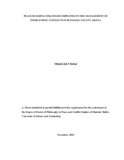PEACE BUILDING STRATEGIES EMPLOYED IN THE MANAGEMENT OF INTER-ETHNIC CONFLICTS IN BUNGOMA COUNTY, KENYA
Abstract
Globally, intractability of inter-ethnic conflicts called for the synergy of state and non-state peacebuilding strategies in management of conflicts. In Kenya, specifically in Bungoma County notwithstanding peacebuilding efforts, in 1963 conflict acquired both a political and a national outlook. In 1992 the violence was unparalleled in the region. It is this dysfunction between peacebuilding strategies against inter-ethnic conflict management that the study analysed the efficacy of state and non-state peacebuilding strategies employed in management of inter-ethnic conflicts in Bungoma. Specific objectives were: to examine the nature of inter-ethnic conflict in Bungoma County, to evaluate peacebuilding strategies by the state and non-state actors in management of inter-ethnic conflicts in Bungoma County, to assess the challenges and opportunities in the management of inter-ethnic conflict in Bungoma County. The study fills a dichotomous knowledge gap between peacebuilding strategies and inter-ethnic conflict management, updates and equips Kenya’s national policy on peacebuilding and conflict management, and it underpins interpretvism research philosophy. The study adopted a conceptual framework underpinned by two theories Gultang’s Conflict Triangle and Lederach’s Conflict Transformation. The study used a descriptive research design. The study was conducted in Bungoma County. The study used both simple Radom sampling and purposive sampling to determine participants. A sample size of 400 participants was achieved from 1375065 population using Yamane 1967 formula. The sample size was distributed proportionately and purposively. Questionnaire, interview and FGD were used to collect primary data while document analysis gathered secondary data. Quantitative data was analysed using MS excel while qualitative data was analysed by thematization, corroboration and verification. The study findings were: Breakdown of inter-ethnic cultural values, cattle raids and land including leadership contests defined the nature of inter-ethnic conflict. 42% of respondents concur that elders were key in influencing inter-ethnic co-existence, inter-ethnic marriages was rated at 23%, shared culture at 20% and trade at 15%, but were alienated and differentiated against inter-ethnic integration by colonisation. Statist peacebuilding efforts mutated from precipitating conflict to inter-ethnic integration of ethnic diversity policies into politics, leadership, administration, employment, election, resource distribution, inter-ethnic identity and in national developmental goals. Relational recovery by CSOs involved reconciliation, workshops, inter-communal projects and post-conflict experience sharing. Breakdown of inter-ethnic cultural values, domination of majority over minority, land and boundary disputes and inter-ethnic inequitable development challenged peacebuilding strategies while affirmative action, hybridization of inter-ethnic cultural values, equity policies were avenues identified for inter-ethnic integration. The study concludes that, notwithstanding state and non-state peacebuilding efforts employed in management of inter-ethnic conflicts in Bungoma County there were glaring challenges to overcome. The study recommends for translation of inter-ethnic peacebuilding initiatives in Bungoma into a documentary and creative art in order to increase awareness of peacebuilding avenues, registration of all land in the County, detach administrative cum political boundaries from ethnic boundaries, design an integrated inter-ethnic peacebuilding manual.

